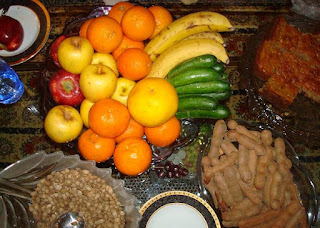Wednesday, March 25, 2009
 Last night Frank and I enjoyed a lovely dinner with friends. All the food was wonderful but two
Last night Frank and I enjoyed a lovely dinner with friends. All the food was wonderful but twothings stood out: several delicious Iranian and seasonal Kurdish dishes. The Kurdish dishes were based on several plants that are only available for 2-3 weeks in the brief (but glorious) Kurdish springtime. One of my favorites was ganggruk which are the shoots of some kind of thistle plant. Preparing these can be murderous on the fingers, but they are delicious when cooked and prepared as a kind of raita.
Even though Frank and I paced ourselves and only tried modest samplings of the various dishes, we were completely full by meal's end.
But then.
We had forgotten the delightful Kurdish tradition of "evening fruit". After dinner, the family
gathered in the sitting room and out came the fruit--and nuts--and sweets. As if we had room!
This tradition is common to most Kurdish families, whatever their station in life. The variety of fruits, nuts, and other items varies according to season, a family's resources, and, I think, the "status" of the guest.
 Last night it was apples, bananas, oranges, cucumbers (always a popular item), dates, giant pistachios (festaq), mixed nuts--and a new one for me: tamarind. Although I know tamarind as a drink and a flavoring for cooking, I didn't know that you can eat them. Longish, brown pods that are broken open to reveal irregularly shaped seeds covered with a dark, chewy fruit. Delicious, really! Also on offer for those with super strong teeth were the dried flower pods from the ganggruk thistle plant (mentioned above).
Last night it was apples, bananas, oranges, cucumbers (always a popular item), dates, giant pistachios (festaq), mixed nuts--and a new one for me: tamarind. Although I know tamarind as a drink and a flavoring for cooking, I didn't know that you can eat them. Longish, brown pods that are broken open to reveal irregularly shaped seeds covered with a dark, chewy fruit. Delicious, really! Also on offer for those with super strong teeth were the dried flower pods from the ganggruk thistle plant (mentioned above).
gathered in the sitting room and out came the fruit--and nuts--and sweets. As if we had room!
This tradition is common to most Kurdish families, whatever their station in life. The variety of fruits, nuts, and other items varies according to season, a family's resources, and, I think, the "status" of the guest.
 Last night it was apples, bananas, oranges, cucumbers (always a popular item), dates, giant pistachios (festaq), mixed nuts--and a new one for me: tamarind. Although I know tamarind as a drink and a flavoring for cooking, I didn't know that you can eat them. Longish, brown pods that are broken open to reveal irregularly shaped seeds covered with a dark, chewy fruit. Delicious, really! Also on offer for those with super strong teeth were the dried flower pods from the ganggruk thistle plant (mentioned above).
Last night it was apples, bananas, oranges, cucumbers (always a popular item), dates, giant pistachios (festaq), mixed nuts--and a new one for me: tamarind. Although I know tamarind as a drink and a flavoring for cooking, I didn't know that you can eat them. Longish, brown pods that are broken open to reveal irregularly shaped seeds covered with a dark, chewy fruit. Delicious, really! Also on offer for those with super strong teeth were the dried flower pods from the ganggruk thistle plant (mentioned above).We sat, we watched Kurdish television (which features endless Kurdish dancing especially in the Nawroz season), we nibbled from the trays of fruits and nuts, and we "chatted" in a mixture of broken English, Kurdish, and Farsi. A thoroughly pleasant tradition.
Even if we didn't have room for more.